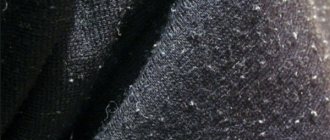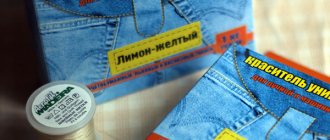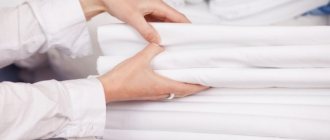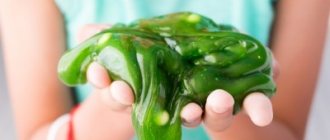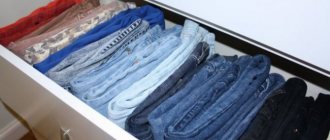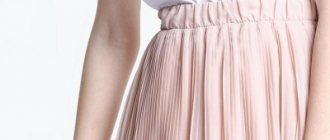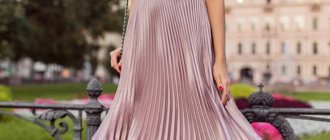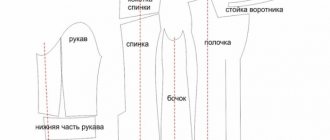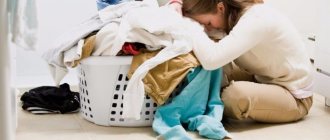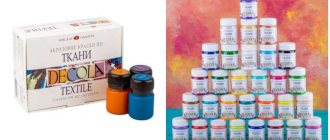Many women like pleated dresses and skirts because they add tenderness and romanticism to their looks. Pleating fabric at home is a simple process, although it requires care. From the resulting material it will be possible in the future to sew products that do not differ from production ones.
Pleating on a template
First you need to make a template, which can then be used repeatedly to pleat the fabric. To do this you will need:
- drawing paper - the size and number of sheets depend on the type of parts;
- fabric with adhesive base;
- long ruler or metal construction meter;
- scissors, pencil, stationery clips;
- iron with steam generation function;
- any heavy load.
Making a template and performing pleating is carried out in the following sequence:
- Draw whatman paper in accordance with the planned width of the folds. It is important to maintain precise markings so that the pleating is smooth and uniform.
- Fold the sheet like an accordion along the marked lines, laying the folds in one direction.
- As folds form, iron them with steam and secure the edges with paper clips.
- Prepare a fabric with an adhesive base (you can take any material and coat it with silicone glue) the same size as the folded paper “accordion”. Glue the fabric to one side of the Whatman paper blank. Iron the template thoroughly and dry it.
- Now you can do it on pleated fabric. Place the material for the skirt or decorative detail into the resulting template and ensure that the folds are even.
- Cover the template with the workpiece with a linen cloth and gently iron it with plenty of steam several times, avoiding movement.
- Place heavy objects on the template and leave to stand for 8-10 hours.
- After the time has passed, remove the pleated.
Natural fabrics should be ironed through a cloth soaked in a fixing solution (stir 20 grams of soap shavings and 2 tablespoons of vinegar in 3 liters of water).
What is corrugation
The original word "corrugation" is from French meaning "to stamp a pattern", but very often it also means creating wavy folds. Corrugation is applied to metal, cardboard, asbestos-cement boards, hair and fabrics. This process makes the product more durable.
Corrugated fabric
Corrugated fabric is characterized by folds of the same width and hem, which are directed one after another. They should always have one direction - either down or up. Folds can be straight, expanding downward, or curly. They are so well designed that they do not lose their appearance when washed.
The fabric is usually pleated for clothing, curtains, tablecloths, blinds, etc. Even bedding sets can be found from such fabric.
Corrugated products
How to restore pleating?
It is necessary to take care of pleated items with special care. Improper ironing or washing may damage the folds.
Before washing, you need to thread the pleated fabric along the hem and in the middle with non-fading threads so that the folds do not become deformed. Place the product in a washing bag and use only delicate cycles.
You can almost always return your favorite clothes to their original appearance, even if the folds are severely damaged. Algorithm for restoring pleating:
- Baste the broken folds along the entire length or fasten them with pins. Starch and leave to dry.
- Meanwhile, prepare the fixing composition. You will need 1 tbsp. l. sugar and gelatin, 100 ml of thick soap solution, 70 ml of table vinegar. Soak gelatin in cold water for 40-50 minutes. After swelling, add sugar to it and stir until dissolved. Then dilute the mixture with soapy water and add vinegar.
- Remove the pins - the folds on the skirt should be held in place by starch.
- Place the product on a sheet of tracing paper and cover with a cotton cloth soaked in a fixing compound. Place another sheet of tracing paper on top so that the impregnation does not stick to the surface of the iron.
- Iron until completely dry. Now the folds will be fixed.
Pleating looks original and elegant on children's and adult items. The technology for creating folds in fabric will help lovers of needlework to significantly expand their creative capabilities.
This is a quote from Lönn's post. Original post from PLISSE master class.
1) We measure the volume of the hips, since to make a pleated skirt, you need a fabric equal in width to 3 girths along the hip line. For example: hip circumference is 70 cm, then we need a canvas width of 70x3 = 210 (cm). The length of the canvas is equal to the length of your product.
2) We cut our future skirt. When sewing 2 or more parts, it is better to sew the seam open-iron so that there is no excess thickness when folding. We overlock all open cuts. I also overcast the top edge so that the fabric does not fray during the process.
We hem the bottom not reaching 5-7 cm to the edge on each side, for ease of sewing the side seam.
PLEASE NOTE THAT WHEN STITCHING THE SPACE BETWEEN THE FOLDS ON THE FRONT SIDE IS NOT VIOLATED.
We put two sheets together, fasten them and mark them with a needle (the pencil will leave lines on the light fabric), piercing both sheets. This is done to ensure that both the upper and lower parts of the form are marked exactly the same.
We draw lines either with a thick needle with a blunt end, or with a blunt screwdriver without cutting the paper (a screwdriver is preferable, it is more convenient to hold and regulate the pressure on the paper). When making the sample, I used an old manicure set.
Pyramid corrugated shapes
There are 3 types of corrugated forms:
- linear;
- pyramidal;
- decorative.
Clothing with corrugation of different shapes.
The pyramidal shape deserves special attention. This is what is most often used to make fabric for clothing. This shape is characterized by alternating different stripes - wide and narrow. To implement it, you need to immediately calculate how many stripes should fit in order for the finished product to look beautiful.
Corrugated fabric in the product
Corrugated fabric: who is it suitable for, how to make it at home
The word “corrugation” is used in various meanings, denoting both a spectacular hairstyle and a corrugated hose, but most often it is used for fabric gathered into small folds. A special feature of corrugation is the same width of the fold and hem, as well as the fact that the edges of the folds are directed alternately either up or down. The configuration of the folds can be different - classic vertical for straight skirts, narrow at the top and widening at the bottom, creating a flared hem, curly (in the form of herringbones, zigzags, etc.) . The fashion for such clothes began in ancient times, and continues to develop successfully today.
Origin story
Historians were unable to name the exact date of the appearance of the fabric. Most scientists agree that the first examples of pleated clothing appeared in Ancient Egypt. The corrugation emphasized the curves of the body. Such models were available only to wealthy citizens, and were initially used in men's clothing.
Later, noble Egyptian ladies began to decorate their costumes (“kalaziris”) with pleated details. Artifacts that have survived to the present day have become evidence that men's costumes for celebrations existed in Ancient Greece. This type of clothing was called schenti.
In the clothing of different nations, there are models with ironed folds: corrugation in the attire of warriors from the time of Alexander the Great, the Scottish kilt, the trim of the national Azerbaijani costume and many other examples. Corrugated fabric did not always serve as a tribute to fashion - the folds provided freedom of movement (for example, in a warrior’s attire).
Corrugation moved from men's fashion to women's fashion, the size of the folds changed. In the 17th century, with the advent of pleated clothing, it received a certain status. Today, corrugated fabric is a canvas on which folds are laid in a fan-shaped manner (accordion style). Their width can change chaotically.
Pleated or ruffled skirt
The word pleated means "fold" in French. This word refers to both directly pleated and corrugated items. So what's the difference?
Pleated is a fabric with even folds. They can be narrow or wide, but most importantly they are the same from start to finish. At the time of production, each fold is well fixed under pressure.
Corrugations are folds extended towards the bottom. They can be the same, alternate in groups or have a curly shape. The production technology as a whole is no different from pleated.
Looks for cold weather
Ruffled fabric is the perfect way to create a stylish look for any occasion.
Sports looks
Now these skirts are very popular, and the length is absolutely not important - from mini to maxi. They are considered a very versatile wardrobe item. They emphasize femininity and are suitable for any occasion.
As for the material, most often such skirts are made of silk or chiffon. This is explained by the fact that the ensemble of technology and fabrics creates a unique feminine and airy image. Such skirts are definitely not suitable for a winter look, so some designers make them from thick cotton or woolen fabric.
Who and where is corrugation suitable for?
In contrast to the more strict and simple to perform pleats, corrugation is quite demanding both in terms of the level of execution and the figure of the owner of this outfit. This treatment is most often carried out on thin fabrics, although in the latest fashion collections you can find pleated leather and other unusual materials. The peculiarity of corrugation is that it creates both a very good fit and an airy, flying effect.
Skirts, dresses, blouses and even ruffled trousers are very feminine, aristocratic and elegant; such outfits are often made in layers. They are considered sophisticated clothing, although an elegant ruffled blouse goes well with a business suit. Shoes and accessories for this outfit should also be elegant and feminine.
However, when choosing a suitable outfit model, you need to remember that folds raised “on the edge” tend to visually increase volume, so a fully ruffled bodice or skirt will look advantageous only on a thin figure.
It should also be taken into account that the corrugations look beautiful only when the fabric lies freely, otherwise the uneven width of the folds stretched differently can play a cruel joke on you.
Those with round shapes should limit themselves to corrugated inserts, which have the ability to “conceal” the silhouette and can have a wide variety of shapes.
A ruffled collar, scarf or cape, which looks great on a woman of any age and body type, will give a very stylish look to any ensemble.
Choosing clothes to match a pleated skirt
When wearing a pleated skirt, it is very important to understand that despite the long vertical lines, which are usually supposed to slim and lengthen the silhouette, it visually adds centimeters to the hips. Therefore, the figures suitable for such clothes are thin girls, or girls with broad shoulders.
For short stature, it is better not to choose very long models, they will visually reduce your height even more.
At the same time, a pleated skirt is a universal item in the wardrobe that can be worn with anything. It will be ideally combined with a T-shirt and a warm sweater. In addition, even long outerwear with such a skirt will look as stylish as possible. Products made from different textures (for example, chiffon and wool) will also combine beautifully.
Bows with skirts
In cold weather, a pleated wool skirt with a fur vest goes very nicely, and you can brighten up the look with bright accessories. Fashion experts also believe that products with lurex thread are appropriate in cold weather. In warmer times, you can wear a jacket or jumper on top. It is appropriate to wear a blouse under a skirt for the office.
Note! Shoes for such a skirt can also be absolutely anything: sandals, ballet flats, high-heeled shoes, sneakers and even sneakers.
The most popular skirt option is still a midi. With it you can create as many images as possible. It can be either a pencil style, a trapezoid, or a sun. Recently, asymmetrical models have also begun to come into fashion.
Designers advise choosing pleated skirts in rich colors or, conversely, diluting the calm colors of the skirt with a bright top, shoes or accessories. All fashion catwalks are now filled with corrugated fabrics, so while viewing the shows you can choose an interesting modern look for yourself.
Look options for any weather
Care instructions
Important! Ironing, steaming and wringing are prohibited!
Corrugated items are washed separately from others on a delicate cycle. To maintain the shape, the folds are first sewn up with a thin needle by hand using long stitches.
It is unacceptable to use bleaches and other aggressive products.
The product is dried without removing hand stitches. After complete drying, the threads are carefully removed.
Store rolled up (vertically).
In case of heavy soiling, dry cleaning is acceptable.
Drying corrugated products
As has already become clear, corrugated fabric is very unique. Therefore, you need to be very meticulous about care. Drying corrugated items has its own nuances:
- You should dry them only in a completely straightened form, hanging them on hangers; be sure to straighten each fold;
- Before drying, do not squeeze the product too hard to avoid bruising;
- Dry delicate fabrics with steam (you can fill the bathtub with hot water and hang the item in the same room - it will straighten out).
What to do if the corrugation effect disappears
Unfortunately, sometimes it happens that even if you take into account all the nuances of care, something goes wrong and the folds on your clothes disappear. To prevent this from happening, you can dry the product by rolling it into a tube. If this does not help, then you should resort to one of these methods:
- Before smoothing the product, rub each corner with soap on the reverse side, form folds with your hands and iron well (do not use this method on delicate fabrics);
- Grate laundry soap and dissolve in water, add 1 egg white, a spoonful of vinegar and a little starch, then moisten gauze in this mixture and iron the item through it (you can put a sheet of paper on the gauze so that it does not stick to the iron).
Pleated dresses
